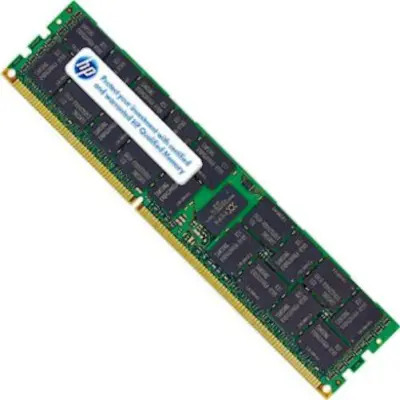HP 367553-001 2GB 333MHz 2Rx4 184 Pin ECC DDR Memory

Shipping $99+
$74.00
HP 367553-001 Product Specs
| Brand | HP |
| Capacity | 2GB |
| Memory Speed | 333MHz |
| Data Integrity Check | ECC |
| Voltage | 2.5v |
| Rank | 2Rx4 |
| Latency Timing | CL2 |
| Pins | 184 Pin |
| Memory Technology | DDR |
| Memory Form Factor | DIMM |
| HPE Server Generations | Gen 4 |
HP 367553-001 Description
The HP 367553-001 2GB 333MHz 2Rx4 184 Pin ECC DDR Memory is a reliable and efficient memory module designed to enhance the performance of your HPE ProLiant servers. Ideal for use in a variety of server models including ProLiant DX, DL, ML, SL, BL, XL, and CL series, this memory module ensures stable and error-free operation thanks to its ECC (Error-Correcting Code) technology. Whether you're upgrading your server's memory capacity or replacing faulty modules, this 2GB DDR DIMM is a perfect fit for Gen 4 HPE server generations, providing seamless compatibility and improved system responsiveness.
Key specifications of this memory module emphasize its balance of speed, reliability, and compatibility. Operating at 333MHz with a CAS latency of CL2, it offers efficient data processing speeds suitable for various enterprise applications. The 2Rx4 rank and 184-pin configuration align with standard DDR memory form factors, making installation straightforward. Additionally, the low voltage requirement of 2.5V helps reduce power consumption while maintaining optimal performance.
- Brand: HP
- Capacity: 2GB
- Memory Speed: 333MHz
- Data Integrity Check: ECC (Error-Correcting Code)
- Voltage: 2.5V
- Rank: 2Rx4
- Latency Timing: CL2
- Pins: 184 Pin
- Memory Technology: DDR
- Memory Form Factor: DIMM
- HPE Server Generations: Gen 4
For maintenance or replacement purposes, compatible spare part numbers include:
HP 367553-001 Compatiblity
| Proliant ML150 | G2 |
| Proliant ML350 | G4 |
Payment Options
All Credit Cards Accepted + PayPal
PO Accepted from Qualified Businesses and Government Entities
Delivery Options
Overnight and Express Delivery in USA
Get within 1 to 3 days
Free Ground in USA
2 to 6 days (Varies by location)
$49 Ground Shipping To Canada
International Delivery Options Available
Contact Us For Detail
Return & Warranty
30 days return
Warranty vary by product please see our Policies page
Trusted by 5000+ IT Managers, System Integrators & Data Center Experts


Easy Returns
"We purchased the wrong part by mistake. Boost hardware made it easy to return and quickly issued me a refund.""

Lowest Price By Far
"We were able to purchase 10x HP 782995-001 for 25% less than the next lowest price. Very impressed with the quick shipping and lack of issues."

Excellent Customer Service
"Excellent customer service; they got in touch with me right away. They upgraded my next order to free 2-day shipping."

![]() We found 4 subs for the HP 367553-001
We found 4 subs for the HP 367553-001

- Memory Technology: DDR
- Capacity: 2GB
- Brand: HP
- Voltage: 2.5v
- Pins: 184 Pin
- ECC: ECC
- CAS Latency: CL2
- Chipset: 2Rx4
- Memory Form Factor: DIMM
- Memory Speed: 333MHz

- Memory Technology: DDR
- Capacity: 2GB
- Brand: HP
- Voltage: 2.5v
- Pins: 184 Pin
- ECC: ECC
- CAS Latency: CL2
- Chipset: 2Rx4
- Memory Form Factor: DIMM
- Memory Speed: 333MHz

- Memory Technology: DDR
- Capacity: 2GB
- Brand: HP
- Voltage: 2.5v
- Pins: 184 Pin
- ECC: ECC
- CAS Latency: CL2
- Chipset: 2Rx4
- Memory Form Factor: DIMM
- Memory Speed: 333MHz

- Memory Technology: DDR
- Capacity: 4GB
- Brand: HP
- Voltage: 2.5v
- Pins: 184 Pin
- ECC: ECC
- CAS Latency: CL2.5
- Memory Form Factor: DIMM
- Chipset: 2Rx4
- Memory Speed: 333MHz
Customer Reviews
Availability
New Condition: In Stock
Refurbished Condition: In Stock
Delivery Options
Overnight and Express Delivery in USA
Get within 1 to 3 days
Free Ground in USA
2 to 6 days (Varies by location)
$49 Ground Shipping To Canada
International Delivery Options Available
Contact Us For Detail
Payment Options
All Credit Cards Accepted + PayPal
PO Accepted from Qualified Businesses and Government Entities
Return & Warranty
30 days return
Warranty vary by product please see our Policies page

